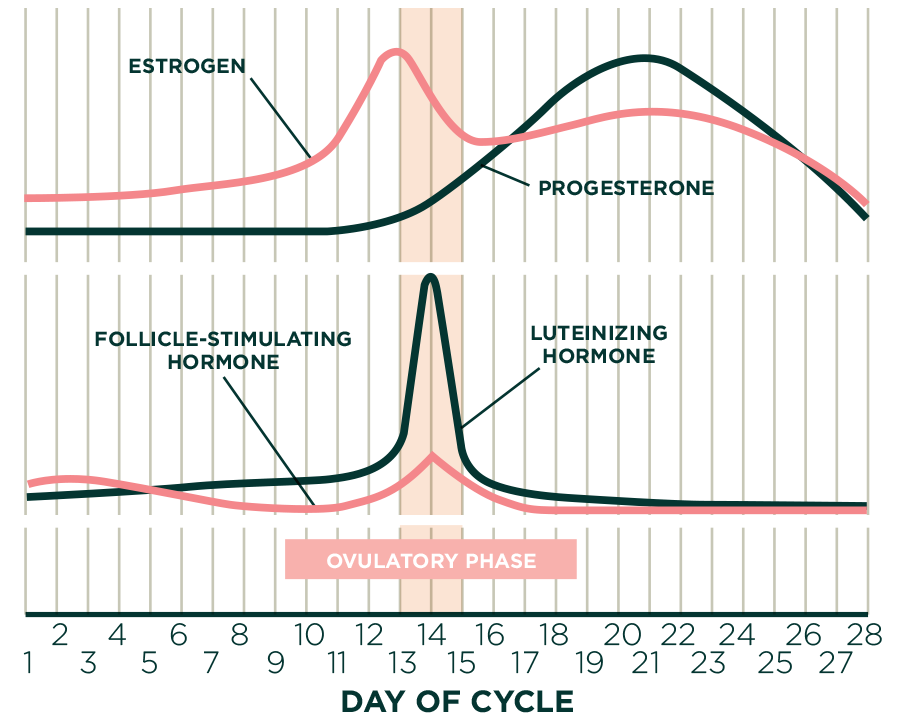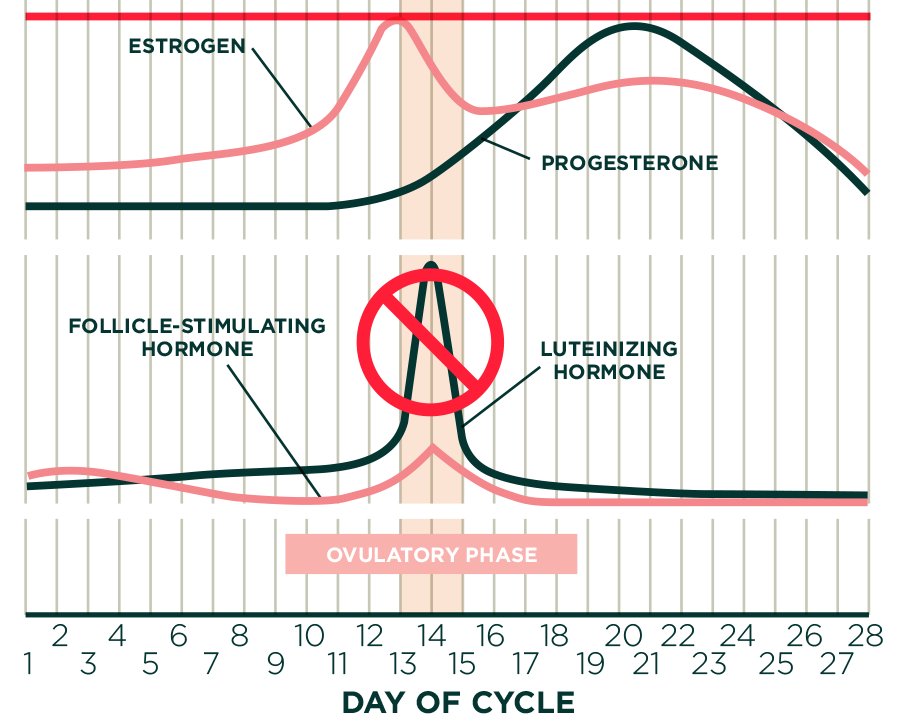Blame it on the hormones
Who are the main players in your cycle?
Understanding how hormonal contraception works requires an understanding of what is happening in your lady-parts.
STEP ONE – MEET THE HORMONES INVOLVED.

FOLLICLE STIMULATING HORMONE, AKA FSH:
This hormone is made in your pituitary gland, all the way up in the base of your brain. Early on in your cycle FSH levels give a little jump and tell your ovaries to start prepping the eggs.
Closer to the middle of your cycle (right between periods) FSH and it’s bestie Luteinising Hormone (more on them in a minute) rise up sharply and trigger the release of a mature egg from an ovary, ready to find it’s perfect spermy match.1

LUTEINISING HORMONE, AKA LH:
This hormone is also made in the pituitary gland located at the base of your brain. A rise in the level of LH is responsible for releasing an egg from your ovary right in the middle of your cycle.¹

OESTROGEN AKA ESTRADIOL:
This is the hormone made by your ovaries and is also produced in the corpus uteum and placenta.2,3 Oestrogen’s job is to thicken up the lining of the uterus and make a nice snug environment for a fertilized egg to stick to and start growing. Oestrogen levels rise right before ovulation to ensure everything is ready and welcoming.¹

PROGESTERONE:
Once the egg is released it leaves behind the follicle that it was growing in (like an eggshell or cocoon), and this follicle starts to produce progesterone.1 Progesterone works with oestrogen to prepare the uterus, making sure the lining (endometrium) is nice and thick and filled with nutrients. Progesterone causes the mucus in the cervix to thicken so bacteria is less likely to get in and also raises the body’s temperature slightly so everything is warm and comfy in preparation for receiving a fertilised egg.1 If the egg is not fertilised or does not implant in the endometrium then progesterone levels drop and menstruation begins.1
How can we manipulate these hormones to control fertility?
STEP TWO IS UNDERSTANDING WHAT HAPPENS AT DIFFERENT TIMES IN YOUR MENSTRUAL CYCLE, BECAUSE ONCE WE KNOW WHAT IS HAPPENING, WE CAN START MANIPULATING THINGS TO ACHIEVE CONTROL!
In the first half of your menstrual cycle (during your period), oestrogen and progesterone are laying low.1 FSH gives a little jump to kick off the process, so your ovary starts prepping an egg. As you reach the middle of your cycle (in between periods) FSH and LH spike, triggering an egg to pop out of the ovary.1 This sets off oestrogen and progesterone who come racing in to get the uterus all nice and comfy and ready for a fertilized egg.1 A fertilized egg needs to implant itself into the lining of the uterus (endometrium) for pregnancy to occur. If no fertilization or implantation occurs, there is no pregnancy. In this case progesterone and oestrogen levels drop back down and your body will shed the egg and the lining of the uterus, causing a period!1,4

NOW… TO TAKE CONTROL!
One option would be to stop FSH and LH from prepping and releasing an egg – but it’s a lot easier to add something to the body than to stop it from doing something.4,5
Luckily, when oestrogen and progesterone are being made they naturally suppress the production of FSH and LH, which is why hormonal contraceptives are made up of an oestrogen and a progesterone (or a progesterone alone).4 Maintaining oestrogen and progesterone levels similar to those seen after ovulation stop another egg from being prepped and released.1,4
As an added bonus the progesterone levels also maintain a nice thick cervical mucus which helps prevent sperm from entering.1

Natural and synthetic hormones explained
Now we know that oestrogen and progesterone are the main players in hormonal contraceptives let’s look at the forms they come in.
OESTROGEN – COMES IN TWO MAIN VARIETIES:6
NATURAL
Identical to (or metabolised to a form that is identical to) oestrogen produced by the ovaries
• Estradiol
• Estradiol valerate
• Estetrol
SYNTHETIC
Chemical structure slightly altered to increase absorption in the body
• Ethinylestradiol
• Mestranol

PROGESTERONE VARIETIES (KNOWN AS PROGESTINS OR PROGESTOGENS);6
• Dienogest
• Drospirenone
• Desogestrel
• Gestodene
• Nomegestrol
• Etonogestrel
• Cyproterone*
*Only approved for use in individuals with hirsutism or severe acne.6

References: 1. Knudtson J and McLaughlin JE, MSD Manual: Menstrual cyle. Available from: https://www.msdmanuals.com/en-au/home/women-s-health-issues/biology-of-the-female-reproductive-system/menstrual-cycle (accessed August 2021). 2. Hariri L and Rehman A, Estradiol, StatPearls [Internet]. Treasure Island (FL): StatPearls Publishing; 2021 Jan. 3. Tal R, Taylor HS. Endocrinology of Pregnancy. [Updated 2021 Mar 18]. In: Feingold KR, Anawalt B, Boyce A, et al., editors. Endotext [Internet]. South Dartmouth (MA): MDText.com, Inc.; 2000-. Available from: https://www.ncbi.nlm.nih.gov/books/NBK278962/ (accessed August 2021). 4. Harvard University, Science in the news: Taming the cycle: how does the pill work? March 15, 2008. Available from: https://sitn.hms.harvard.edu/flash/2008/issue40/ (accessed August 2021). 5. Cooper DB and Mahdy H, Oral contraceptive pills, StatPearls [Internet]. Treasure Island (FL): StatPearls Publishing; 2021 Jan. 6. Therapeutic Guidelines, Combine hormonal contraception. Available from:https://www.tg.org.au/ (accessed August 2021).
